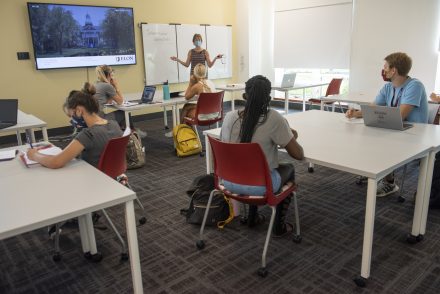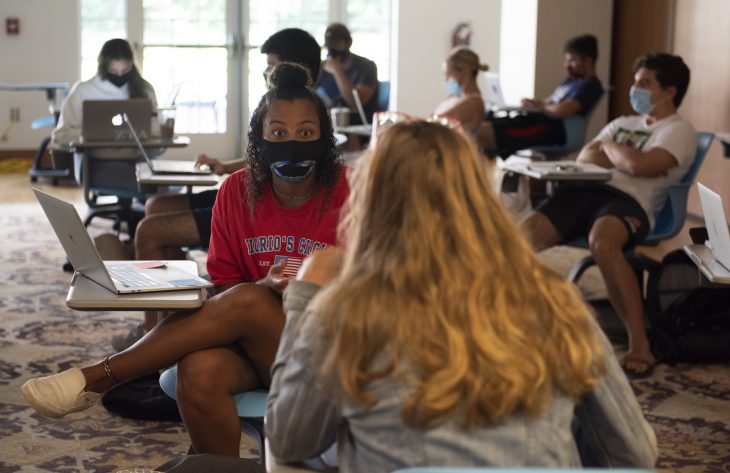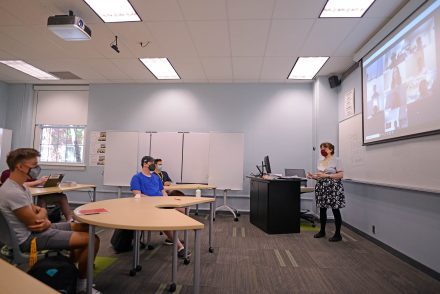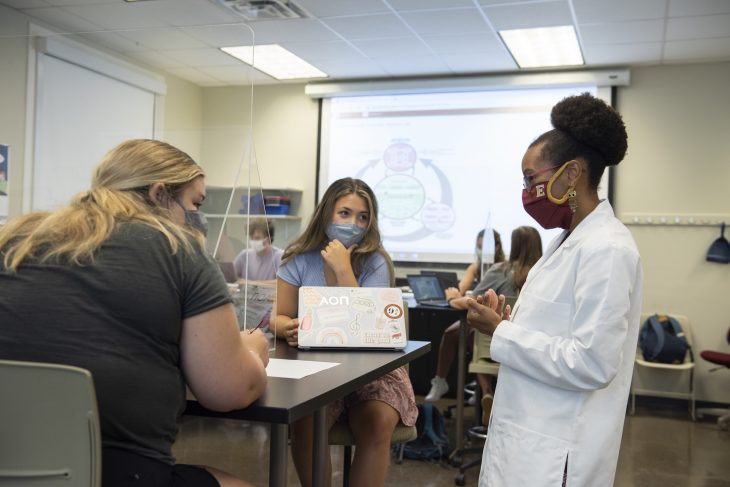Faculty in Elon College, the College of Arts and Sciences, spent the summer reexamining instruction and finding ways for students to connect with content and each other.
Though the Fall 2020 semester looks different, engaged learning, meaningful relationships, and student support remain at the center of courses in Elon College, the College of Arts and Sciences.
Throughout summer, faculty diligently planned and restructured courses to hybridize them for both in-person and online learning. Through independent work and support from summer workshops, they honed their courses to essential objectives. They incorporated new technologies to create new learning space and opportunities for students to interact with course materials and each other, and they built contingency plans for various possibilities, including how to teach students in quarantine and mapping a structure for courses to continue if campus shifts to all-remote classes.

“If anybody thinks this was thrown together, it wasn’t,” said Amy Johnson, executive director of the Elon Core Curriculum and associate professor of history. “Every member of the faculty has done a lot of work to be prepared for all potential ways we may have to engage students with information, and also to meet students on an emotional and personal level. Hybrid, high-flex teaching may be the biggest test of our expertise as faculty.”
That dedication is paying off as Elon transitions to a new normal: Students are quickly becoming familiar with previously unfamiliar processes, and faculty have fostered new learning spaces where knowledge is strengthened and shared. Already faculty are seeing the potential for these new methods to become standard features of future in-person classes because they increase engagement.
Many courses within Elon College, the College of Arts and Sciences are being taught in hybrid forms this fall. Using a combination of in-person (or “mask-to-mask” as some call it) class time and online exercises, faculty are working to make the most out of each. Individual faculty have devised variations to better mesh with course material and ensure learning and student support.
‘It’s shifting my whole pedagogical framework.’
Damion Blake, assistant professor of political science and policy studies, restructured his POL 141: International Relations and POL 313: American Politics Through Film courses to adapt them to online spaces and incorporate issues around the pandemic. He took training courses for Zoom and Prezi, a presentation tool that allows students to interact with lecture slides. He spent hours uploading the readings and files to Moodle.
You have to be very deliberate and calculated in keeping the conversation and interactions going online.
Assistant Professor Damion Blake
At first, Blake envisioned a blend of synchronous and asynchronous materials, but transitioned to a primarily synchronous form using Zoom, its break-out rooms and Prezi after the first day. It felt more authentic to his teaching style and the charged conversations integral to each course.
“We had rich discussions online and I think it was better,” Blake said. “You have to be very deliberate and calculated in keeping the conversation and interactions going online. You have to create different kids of activities to keep engagement going.”
Blake is also more deliberate in making himself available to students, giving them his phone number, answering emails at all hours, and opening up weekends to them if they request it.
“It’s double the work. This process makes you reflective and introspective. You wonder: Am I doing this the right way?” Blake said. “Just being in the classroom and maintaining safety protocols and distancing, … it’s shifting my whole pedagogical framework.”
‘We needed to make sure we did this right.’
Flipped classes — with pre-recorded lectures and reading students complete asynchronously before class — are popular. Class time is used for discussions, group work, or to dive deeper into subjects and problem-solving.

Chemistry faculty worked together this summer to plan and deliver CHM 111: General Chemistry I in a flipped format. There are eight sections of the course this fall taught by six faculty. Each week, a different professor records and uploads four to five video lectures for all eight sections’ Moodle sites. In-class time is used to iron out complex issues and spend more time on practice problems.
“This course is foundational. We needed to make sure we did this right,” said Associate Professor Dan Wright, the course’s coordinator.
Mondays are used for extended office hours and question-and-answer sections. Classes are held Wednesdays and Fridays. The structure allows for greater uniformity of content, more flexibility if faculty or their families fall ill, and more one-on-one time with students, Wright said.
Wright sees potential in using the flipped classroom model as part of future courses because it allows for more engagement and time spent with hands-on activities in class.
‘I had to create better and more sharply focused assignments.’
In the English Department, Professor Rosemary Haskell modified the structure of ENG 222: British Literature After 1800 for greater safety. Though the course meets in Oaks 212, a space large enough to accommodate the full class in-person each Tuesday and Thursday, Haskell was concerned about keeping that many students in a room for longer than an hour. To reduce in-class time, she releases them after an hour to work individually or in small groups for the remaining 40 minutes. They turn in daily assignments on Moodle by the end of the period.

Thinking critically about the course and its objectives day by day helped Haskell, who’s taught at Elon for 25 years, strengthen the course. The “small, bite-sized” assignments and activities may take only a few minutes, but they reinforce the material in new ways, she said.
“I had to create better and more sharply focused assignments for the topics addressed that day,” Haskell said. “Having to formalize the lessons so clearly has been good for me, for example by rethinking what’s important in reading Romantic poetry, and how to use that particular critical perspective.”
‘They approach it like a scholarly discipline.’
Faculty members didn’t undertake these efforts alone.
Summer institutes by the Center for the Advancement of Teaching and Learning and Teaching and Learning Technologies aided professors in rethinking course structures, planning for unknowns, and integrating new technology into courses. Nearly 200 Elon College faculty participated in CATL’s weeklong Course Design Institute or TLT’s Digital Learning Days. Many enrolled in both.
Deandra Little — CATL director, assistant provost and English professor — said faculty were meticulous in planning for this fall, and that the sudden pivot to remote classes in the spring taught valuable lessons.
Though studies show asynchronous, independent learning may be most effective online, students this spring needed synchronous time with classmates to build and reinforce connections, Little said. Professors designed courses to involve both synchronous and asynchronous elements — the basis of the flipped classroom. Many professors have also extended personal availability through virtual office hours and one-on-one check-ins.

“The issue isn’t whether instruction is synchronous or asynchronous, but whether it’s aligned for learning goals, and that students are getting feedback and understand that faculty are available so they feel that sense of connection,” Little said. “Elon is known for its engaged learning, and our already strong, creative faculty are applying that to this fall. They’ve been doing that work all summer, figuring out how to create learning environments that promote learning in very intentional ways. They approach it like a scholarly discipline.”
And because professors arrive at Elon with a strong desire to teach and mentor undergraduate students, they are also approaching it with joy.
It is so great to be in the same space with my students. It’s not exactly the way I would have wanted, but to be able to go through the material together — there’s nothing like that.”
Assistant Professor Jessica Merricks
Reflecting on her first few days back in class with undergraduates, Assistant Professor of Biologyy Jessica Merricks was surprised at how little wearing masks or monitoring remote students on Microsoft Teams screens distracted from class.
“It is so great to be in the same space with my students,” Merricks said. “It’s not exactly the way I would have wanted, but to be able to go through the material together — there’s nothing like that. I’m having amazing conversations with students, even though we’re wearing masks. Students are connecting and communicating with each other. We’re bonding already. That’s amazing.
“That’s what I needed. I think students needed that too.”



